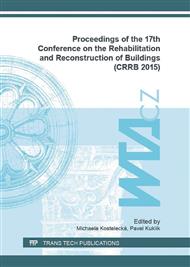[1]
V. Horie, Materials for conservation, 2nd ed., Milton Park, Routledge, (2011).
Google Scholar
[2]
G. Wheeler, Alkoxysilanes and the Consolidation of Stone, California, Getty publications, (2005).
Google Scholar
[3]
C.J. Brinker, G.W. Scherer, Sol-Gel Science - The Physics and Chemistry of Sol-Gel Processing, San Diego, Academic Press, (1990).
Google Scholar
[4]
G.W. Scherer, G.S. Wheeler, Silicate Consolidants for Stone, Key Engineering Materials 391 (2009) 1–25.
DOI: 10.4028/www.scientific.net/kem.391.1
Google Scholar
[5]
M.R. Escalante et al., Particle-modified Consolidants, in: E. Galán, F. Zezza (Eds. ), Protection and Conservation of the Cultural Heritage of the Mediterranean Cities, Balkema, Lisse, The Netherlands, 2002, p.425–429.
Google Scholar
[6]
J. Douce et al., Effect of filler size and surface condition of nano-sized silica particles in polysiloxane coatings. Thin Solid Films 466 (2004) 114–122.
DOI: 10.1016/j.tsf.2004.03.024
Google Scholar
[7]
E.K. Kim et al., Effects of silica nanoparticle and GPTMS addition on TEOS-based stone consolidants. Journal of Cultural Heritage 10 (2009) 214–221.
DOI: 10.1016/j.culher.2008.07.008
Google Scholar
[8]
C. Miliani et al. Particle–modified consolidants: A study on the effect of particles on sol–gel properties and consolidation effectiveness, Journal of Cultural Heritage 8 (2007), 1–6.
DOI: 10.1016/j.culher.2006.10.002
Google Scholar
[9]
M.J. Mosquera et al., New Nanomaterials for Consolidating Stone, Langmuir 24 (2008) 2772–2778.
Google Scholar
[10]
L. de Ferri et al., Study of silica nanoparticles – polysiloxane hydrophobic treatments for stone-based monument protection, Journal of Cultural Heritage 12 (2011) 356–363.
DOI: 10.1016/j.culher.2011.02.006
Google Scholar
[11]
Information on http: /www. us-nano. com/inc/sdetail/411.
Google Scholar
[12]
Definition of electrokinetic potential, IUPAC Compendium of Chemical Terminology, Oxford, Blackwell Scientific Publications, (1997).
Google Scholar


